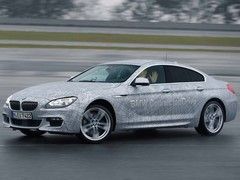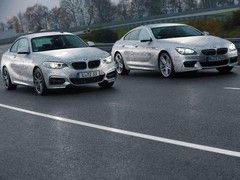BMW launches latest ActiveAssist tech
UPDATE: Now with video, watch an M235i powerslide itself. Weird

Under the 'ActiveAssist' banner, BMW aims to improve the safety of personal transport and 'make a significant contribution to bringing the vision of accident-free mobility closer'. Obviously, the clearest way to indicate this is to show a man in a sideways car making the globally recognised 'look, no hands!' gesture.
In all seriousness though, ActiveAssist does seem another step towards autonomous cars. It uses sensors to detect changing grip levels and so can follow a set course regardless of the surface conditions, so say BMW. The no hands skid is the result of the new function adding 'active and precisely calculated steering inputs' on top of the brake and throttle applications when required. As can be seen in the video as well, this is proper oversteer; no small wiggles here, the 2 Series is fully sideways.
Therefore understeer is dialled out by winding off steering lock and slowing down. Oversteer is countered through 'using a carefully gauged combination of countersteering and brake inputs'. This is permissible thanks to electric steering; and you thought a lack of feel was the big problem...
Combined with 360-degree camera and radar, ActiveAssist is capable of entirely independent driving right up to and beyond the limit of grip and in any conditions. Indeed, a prototype using this tech has already covered over 9,000 miles in testing.
BMW says the next step for ActiveAssist will be a fleet trial for highly automated driving in 2015, a similar test to those carried out with the Mini E and BMW ActiveE a few years ago. The direct result of those was the recently launched i3; are we that far away from an autonomous BMW?
Watch the video here
[Source: BBC News]
Of course I still want to be able to drive for pleasure on country roads and the like, but on motorways there's no fun to be had from driving, AT ALL. So a system to do that for me would be very welcome.
In a purely mechanical car the driver uses their senses (sight, feel, balance etc) to work out where they want to go at any given moment, and apply handwheel and throttle/brake inputs to make the car go in that direction. For most people, most of the time, this is within the purely linear and positive region of control (ie. more handwheel = more turning etc). Once tyre slip at the non steered axle exceeds slip+turn at the steered end, the handwheel direction reverses, and the control becomes very non linear (as the inertia of the car starts to play a large part in the control lag). At this point, most drivers used to crash, but good ones could still operate in this highly non linear region (through experience, training and of course talent!) and continue to make the car follow their chosen trajectory.
Fast forward to the typical car with ESP, and the issue becomes one of deciding where the driver wants the car to go, and helping him go that way. One of the reasons most road ESP systems are thought by skilled drivers to "cut in too early" is because they must try to ascertain the intended vehicle direction before the controls become non linear. Systems that have a high degree of yaw authority and follow the handwheel angle religiously can cause unexpected events during oversteer! ie. the driver has left hand lock on, as they want to corner to the left, but the car oversteers halfway around the bend, so they now put on righthand lock. Should the system now try to turn the car right?
Anyone who's driven a fully "active" WRC car will have learn't to avoid excessive oversteer, because the system really could make the car suddenly reverse it's direction mid corner! As we currently have no other arbitor of intended direction than the handwheel, these systems become a compromise, because they have to work with drivers who's response ranges from "do nothing, just freeze" to "perfect application of opposite lock and drive torque". That is extremely difficult to calibrate for.
So newer systems, like the BMW system shown, now have the capability for full yaw authority as they can now steer themselves with the steering rack. But this means that unless the system somehow uncouples the handwheel from the rack, it cannot use the handwheel angle as it's trajectory request, it must take information from other sources (GPS, radar, laser scanners etc). For such a track test as shown in that video, that is quite easy, as it is not hard to pre-program a simple course through some cones under controlled conditions. However, in the real world, the task of integrating that system with a "real" driver and obeying their requests is very very difficult indeed. In fact, it would be a lot simpler to just cut out the human driver entirely, as that BMW video shows (ie. hands off all the controls, car does the driving!)
Historically, the aerospace industry has show that the issues surround the cases when both the human and the computer are both thinking the other one is "flying the plane" (see AF447!).
These systems are great...for promotional purposes...put it in the real world and then lets have a look at how the sensors determine what the actual path should be...without a clear steering wheel angle to determine path.
Good luck with that.
Also...the autonomous oversteer mode is subject to the same grip limitations as a normal driver, so if the rear axle moves onto a lower grip surface then the slide may not be recoverable. Is that a good strategy for the public road?
Gassing Station | General Gassing | Top of Page | What's New | My Stuff





